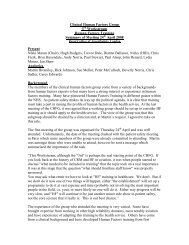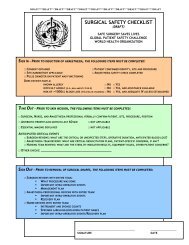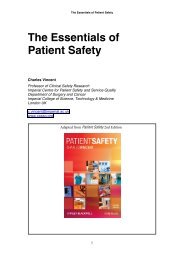Read an anonymous version of Elaine's report, the Inquest Verdict ...
Read an anonymous version of Elaine's report, the Inquest Verdict ...
Read an anonymous version of Elaine's report, the Inquest Verdict ...
You also want an ePaper? Increase the reach of your titles
YUMPU automatically turns print PDFs into web optimized ePapers that Google loves.
In total, during <strong>the</strong> attempts at intubation, Mrs Bromiley‟s oxygen saturation wasextremely low (at or less th<strong>an</strong> 40%) for some 20 minutes.Immediate postoperative careMrs Bromiley was admitted to <strong>the</strong> recovery room at 09.30. Her observations onadmission were a pulse rate <strong>of</strong> 120 bpm, a respiratory rate <strong>of</strong> 20 bpm, blood pressure <strong>of</strong>84/33 mmHg, temperature <strong>of</strong> 35.1 °C <strong>an</strong>d <strong>an</strong> oxygen saturation <strong>of</strong> 95%. The recoverystaff were aware <strong>of</strong> <strong>the</strong> problems that had occurred <strong>an</strong>d were informed by Dr A that hewould expect Mrs Bromiley to recover consciousness slowly. After a short while withMrs Bromiley, Dr A left <strong>the</strong> recovery room to continue <strong>the</strong> operating list.It is clear from <strong>the</strong> statements <strong>of</strong> <strong>the</strong> recovery staff (Nurses D <strong>an</strong>d S) <strong>an</strong>d subsequentinterviews that <strong>the</strong>y were far from happy with Mrs Bromiley‟s condition. Even nearly onehour after admission, <strong>the</strong>re was no sign <strong>of</strong> recovery <strong>of</strong> consciousness <strong>an</strong>d whilst MrsBromiley was breathing, <strong>the</strong> pattern was erratic. The blood pressure was equally erraticwith swings from very high to low; <strong>the</strong> oxygen saturation equally showed swings. Mostconcerning to <strong>the</strong> recovery staff were periodic episodes <strong>of</strong> movement that looked like„fits‟. These were associated with fur<strong>the</strong>r swings in measured parameters. Such are signs<strong>of</strong> cerebral irritation <strong>an</strong>d require prompt, appropriate action.On several occasions, <strong>the</strong> recovery staff asked Dr A to come to see Mrs Bromiley but thatwas not always possible as he had already started to <strong>an</strong>aes<strong>the</strong>tise <strong>the</strong> next patient on <strong>the</strong>operating list. On occasion, Dr B came to see <strong>the</strong> patient, but he, quite legitimately, had aduty <strong>of</strong> care to his own patients. The exact times when requests were made <strong>of</strong> Dr A arenot recorded but it is clear that <strong>the</strong> recovery staff felt that Dr A should have been readilyavailable to deal with <strong>an</strong>y problems.Concerns increased <strong>an</strong>d eventually it was decided that Mrs Bromiley needed to betr<strong>an</strong>sferred to <strong>the</strong> intensive care unit. As both Dr A <strong>an</strong>d Dr B were unavailable, (<strong>an</strong>o<strong>the</strong>rAnae<strong>the</strong>tist) attended to supervise <strong>the</strong> tr<strong>an</strong>sfer. This took place at about 11.00 <strong>an</strong>d MrsBromiley was tr<strong>an</strong>sferred to (NHS) Hospital. At this time, she was in <strong>an</strong> unstablecondition though was still breathing on her own.The exact sequence <strong>of</strong> events is not entirely clear as <strong>the</strong>re is no record <strong>of</strong> measurementsmade. It is normal practice to have written records <strong>of</strong> cardiovascular variables <strong>an</strong>d I c<strong>an</strong>only assume that if such exists, that it has been mislaid.Subsequent m<strong>an</strong>agementIt was not within <strong>the</strong> brief <strong>of</strong> this inquiry to consider <strong>the</strong> m<strong>an</strong>agement <strong>of</strong> Mrs Bromileyoutside The xx Clinic <strong>an</strong>d hence this section reflects <strong>an</strong> overview <strong>of</strong> <strong>the</strong> situation.On admission to <strong>the</strong> intensive care unit at (NHS) Hospital, it was clear that Mrs Bromileyhad suffered marked brain damage <strong>an</strong>d urgently required ventilation. Again <strong>the</strong>re wereproblems with placing a tracheal tube, finally it was possible to insert one through hernose <strong>an</strong>d into her trachea.Mrs Bromiley‟s condition did not improve <strong>an</strong>d her clinical course lead to her ultimatedeath. There was clear evidence <strong>of</strong> severe cerebral damage through her time on <strong>the</strong>intensive care unit.9








